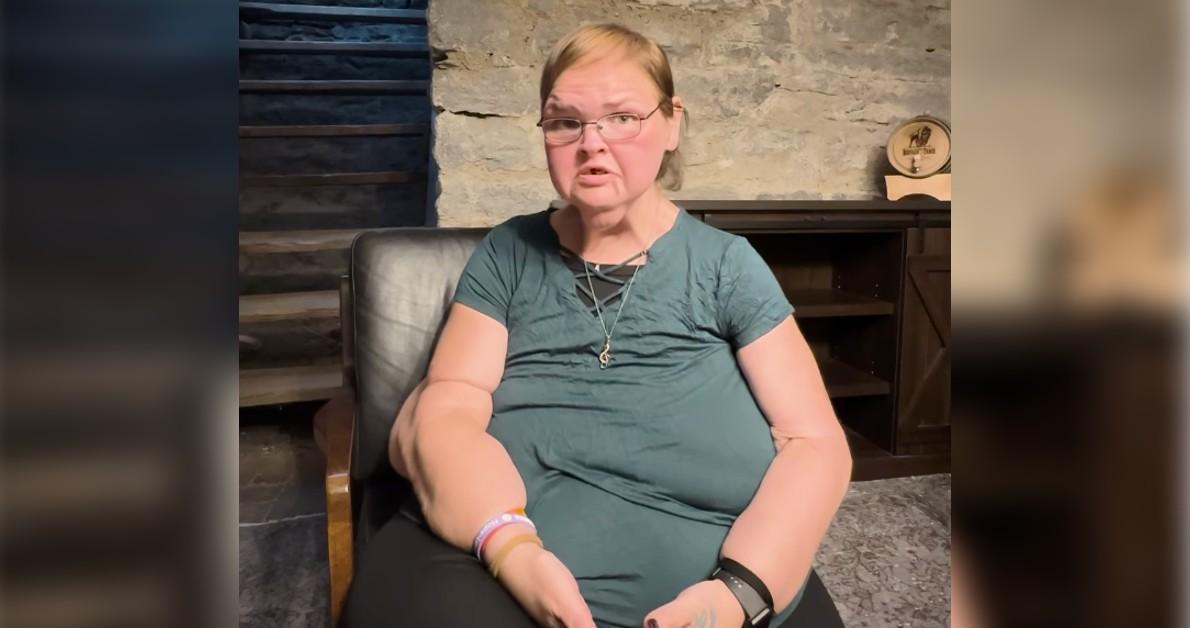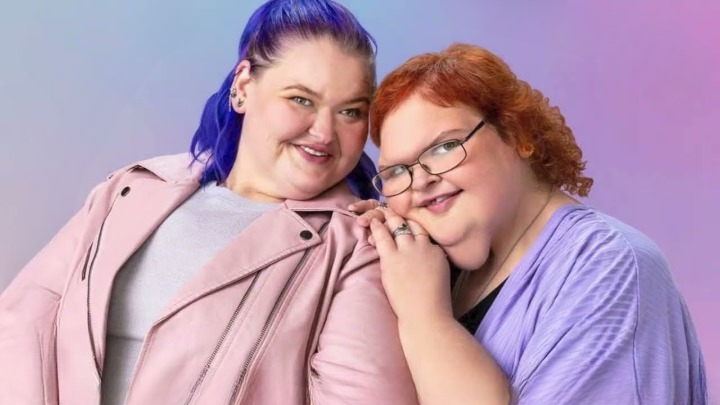The life of Tammy Slaton, best known from TLC’s 1000‑Lb Sisters, has struck a chord across America—not just as entertainment, but as a raw, often painful portrait of struggle, loss, transformation, and the cost of survival. Since her first appearance with sister Amy in 2020, Tammy’s life has unfolded with breathtaking highs and heartbreaking setbacks. Her journey is defined by medical crises, extraordinary weight loss, broken relationships, family tragedies, self‑discovery, and personal revelation. What started as a show about weight loss has evolved into much more: a look at resilience, identity, and what it means to truly fight for one’s life.
A Rocky Beginning: The Early Years
From childhood, Tammy Slaton carried burdens well beyond most young people. Obesity wasn’t merely an issue of weight—it was rooted in trauma, isolation, emotional pain, and limited means. As she grew, her body became something that drew judgment and shame. Bullying and ridicule were part of everyday life. What often began in many people’s minds as the lingering “baby weight” or teenage struggle turned, for Tammy, into a life‑threatening situation. By the time she reached adulthood, her weight had climbed tragically high—hovering above 600 pounds and at points exceeding 700 pounds. Simple tasks like walking across a room, breathing comfortably, or getting dressed became monumental feats. She needed oxygen just to function. Behind those physical limitations were deeper wounds: depression, feelings of hopelessness, a life lived in the margins, unseen and unhelped.

A Public Stage: 1000‑Lb Sisters and the Early Seasons
When 1000‑Lb Sisters premiered in January 2020, it introduced viewers not merely to two sisters battling weight, but to two people fighting for their lives, for a sense of agency, and for visibility. Tammy and Amy came across as inseparable, sharing juvenile experiences, doctor’s appointments, setbacks, hopes, and small victories. Yet even early on, there were signs that what was visible wasn’t the whole picture.
For Tammy, the show was both lifeline and cage. It gave her access—to doctors, to treatment, to medical advice, to rehab—it gave her an audience, a public cheering section. But it also made every failure very public. Every unintended gain, every emotional slip, every conflict with Amy or other loved ones was played out on a national stage. The pressure of being watched, judged, and discussed only magnified her insecurities. Meanwhile, Amy’s path—though difficult in its own ways—began to diverge significantly, with weight loss, surgery, and life changes that Tammy could only see from a distance.
The Diverging Path: Amy’s Rise, Tammy’s Isolation
Amy Slaton made steady progress: bariatric surgery, shedding pounds, building a family, establishing stability. Viewers witnessed Amy becoming a mother, purchasing a home, and creating structures of safety and consistency around herself. Meanwhile, Tammy’s journey was more jagged. She resisted or struggled with diet plans and exercise regimens, pushed away or was hurt by health aides, had outbursts with those trying to help, and often felt trapped by her physical limitations and emotional pain.
As Amy’s life expanded, Tammy’s felt smaller. Isolation deepened. The gap between them grew not just in weight lost but in lifestyle, in ability, in outlook. What had once been mutual support began to feel, for Tammy, more like comparison—and sometimes failure. Yet beneath all of this was the realization that this wasn’t only about weight loss. It was about healing emotional wounds, about reclaiming dignity, about fighting for life itself.

The Breaking Point: Crisis and Awakening
By late 2021, Tammy had reached a dangerous threshold. Her health deteriorated so severely that she suffered a medical emergency, landing in a medically induced coma. This event shocked fans, family, and perhaps most of all Tammy. It became a profound reckoning: there was no more room for denial, no more postponement of hard choices.
When she finally came out of the coma, she was changed—not just physically, but mentally. Her wake‑up call was literal as well as metaphorical. From then on, the work of recovery was no longer optional. Every step, every breath, every small movement had meaning. Survival had become the primary goal.
Long Road Up: Rehab, Surgery, and Transformation
Tammy spent about 14 months in a rehab facility where structure, consistency, and medical oversight weren’t luxuries—they were lifelines. Her days were governed by routine: controlled dietary regimens replaced night binges; therapy replaced isolation; physical therapy and assisted ambulation replaced dependence. Progress was measured in inches, grams, breaths—something most people take for granted.
In mid‑2022, Tammy underwent bariatric surgery, a critical intervention that, combined with the rehab, would become the catalyst for dramatic change. Over time, she lost hundreds of pounds. Recent reports as of 2025 place her weight at around 238 pounds—meaning a loss of over 500 pounds from her heaviest point.
New Challenges: The Hidden Costs of Transformation
Losing weight on that scale is not just about diet or surgery: it brings its own set of complications. Tammy’s body was left with large amounts of excess, sagging skin—on the face, arms, stomach—that affected her mobility, her physical comfort, and her mental self‑image. She needed more surgeries to remove this skin.
Her dental situation, neglected over many years, required extensive attention—extractions, prosthetics, recovery time. She also had to address slower healing, nutritional deficiencies, and the psychological burden of seeing her body changed but still imperfect in many ways.
Financial stress followed. After rehab and surgeries, there were bills, ongoing medical care, and the realization that TLC or public attention wouldn’t cover everything indefinitely. Tammy’s income from the show, social media, or other means could help, but many costs remained. She moved homes, stayed with family at different times, shifted living situations, all while trying to maintain focus on healing.
Mental Health, Identity, and Self‑Discovery
Through all of this, one of the most profound transformations has been internal. Tammy has spoken more recently about realizing that food had become a tool, a crutch, a way to cope with pain, sadness, and isolation. Recognizing addiction—to food, to emotional eating—and starting to untangle those patterns has been a key part of her healing. She’s also had to contend with depression, anxiety, shame, and public scrutiny.
Another layer is identity. After the death of her husband, Caleb Willingham, in 2023, Tammy’s life shifted again in unexpected ways. She has come out as pansexual, and more recently revealed a relationship with a woman named Andrea. In 2025, she referred to Andrea as her “fiancée,” surprising many who had not known about the relationship.
Milestones & Recent Highlights
-
Massive Weight Loss: As of mid‑2025, Tammy has lost over 500 pounds, dropping from a peak of approximately 725 pounds to around 238.
-
Skin Removal Surgery: Several procedures have removed excess skin from chin, arms, stomach; around 15+ pounds of skin removed.
-
New Relationship: Tammy is in a committed relationship with Andrea; she’s revealed they had been together for nearly 3 years and uses the term “fiancée.”
-
Public Reflection & Gratitude: She’s shared videos/photos documenting her journey, publicly expressing how thankful she is for the support of fans, family, and her partner.
-
Improved Health & Mobility: Fitting in a front car seat, moving without being dependent on oxygen and wheelchair/walker usage during day time, being more active, experiencing aspects of life she couldn’t before.
Tragedy & Loss
Despite these victories, Tammy’s path has also been marked by deep grief. Her husband, Caleb Willingham, passed away in 2023. She’s also recently lost her cousin, Katie Slaton, who died at 37 after battling stage 4 gastric adenocarcinoma. That loss rippled through the family and the fan community alike. nine.com.au+2New York Post+2
These personal losses, while private, have played out in the public eye and shaped her emotional arc. They underscore the fragility of life, the unpredictable nature of health, and the burden of carrying others’ expectations while also caring for one’s own wounds.
What It Means: Resilience Beyond the Scale
Tammy’s story is more than a personal saga about weight. It’s a testimony to human resilience. Her life illustrates how healing is rarely linear—it has reversals, plateaus, moments of despair. But also that transformation can come even after near collapse. That the body and mind are capable of extraordinary change, but change doesn’t erase past hurts; it builds upon them.
Her journey also highlights the intersections between physical health, mental health, identity, community, and grief. When you lose 500 pounds, you don’t simply lose weight: you lose an identity, habits, sometimes relationships, and you must rebuild many parts of yourself.
It’s also a story about being seen—by the public, by family, and eventually by oneself. Where once shame and invisibility dominated, Tammy has increasingly chosen visibility, not just through the show, but through her vulnerably sharing what hurts, celebrating what heals, and allowing space for contradiction: that she can grieve and also love; slip up and continue; feel proud and still feel insecure.

